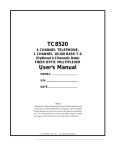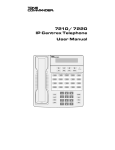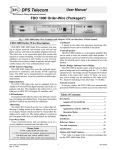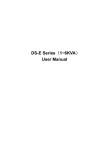Download NEC DS1000/2000 User's Manual
Transcript
Release 02.03.00 Feature Handbook Supplement 80000MFS01 October 2001 Printed in U.S.A. Your Multibutton Display Telephone 80000 -70 CLEAR BIN 1 BIN 2 BIN 3 BIN 4 BIN 5 CHECK BIN 6 BIN 7 BIN 8 BIN 9 BIN 10 LINE 1 LINE 2 LINE 3 LINE 4 LINE 5 LINE 6 LINE 7 LINE 8 LINE 9 LINE 10 LINE 11 LINE 12 ABC DEF 1 2 3 GHI JKL MNO 4 5 6 PQRS TUV WXYZ 7 8 9 OPER MW ICM FLASH DND DIAL MIC LND SPK In DS1000: Keys 7-12 are undefined. For Attendants: Key 11=Night Key Key 12=Operator Call Key 0 VOL ● ● CONF HOLD Your key assignments may be different than shown. Ask your communications manager. See the inside back cover of this guide for an illustration of the Super Display telephone. Nothing contained in this manual shall be deemed to be, and this manual does not constitute, a warranty of, or representation with respect to, any of the equipment covered. This manual is subject to change without notice and NEC America, Inc. has no obligation to provide any updates or corrections to this manual. Further, NEC America also reserves the right, without prior notice, to make changes in equipment design or components as it deems appropriate. No representation is made that this manual is complete or accurate in all respects and NEC America shall not be liable for any errors or omissions. In no event shall NEC America be liable for any incidental or consequential damages in connection with the use of this manual. This document contains proprietary information that is protected by copyright. All rights are reserved. No part of this document may be photocopied or reproduced without prior written consent of NEC America. ©2001 by NEC America, Inc. All Rights Reserved. Printed in U.S.A. Table of Contents Caller ID Logging .............................................................1 Caller ID Logging at your 22-Button or 34-Button Display Telephone . . . . . . . . . . . . . . . . . . . . . . . . . . . .1 Caller ID Logging at your Super Display Telephone . .4 Distinctive Ringing...........................................................7 Distinctive Ring Configuration . . . . . . . . . . . . . . . . . .8 Extension Override . . . . . . . . . . . . . . . . . . . . . . . . . .13 Key Ring Override . . . . . . . . . . . . . . . . . . . . . . . . . . .17 Administration . . . . . . . . . . . . . . . . . . . . . . . . . . . . . .21 Hold Recall . . . . . . . . . . . . . . . . . . . . . . . . . . . . . . . .27 Park Recall . . . . . . . . . . . . . . . . . . . . . . . . . . . . . . . .27 Transfer Recall . . . . . . . . . . . . . . . . . . . . . . . . . . . . .28 Transfer, Handsfree.......................................................29 Volume and Contrast Control........................................30 Volume Control . . . . . . . . . . . . . . . . . . . . . . . . . . . . .30 Contrast Control . . . . . . . . . . . . . . . . . . . . . . . . . . . .32 i ii Caller ID Logging Your phone can store If your system has Caller ID enabled, Caller ID logging stores in a log your caller’s number and phone number for easy optional name for each outside call review and redialing. that rings the system. You can view this log on your telephone display, allowing you to easily review and redial your calls. your caller’s name and The system can log calls directly to your extension — or you may be a member of a Caller ID Logging group that shares records. Your Communications Manager can tell you more. Use the feature and soft keys on your phone to: Scroll through (review) your Caller ID records. Delete records you no longer need. Store a record (both the number and name) in one of your Personal Speed Dial bins. ● Place a return call to the calling party. ● ● ● Caller ID Logging at your 22-Button or 34-Button Display Telephone To review your Caller ID log: 1. While your phone is idle, press CLnn (where nn is the number of Caller ID records currently logged at your phone). – Your Ring/Message Lamp (the large green LED on the upper right corner of you phone) winks on (green) when you have Caller ID records you have not reviewed. – After pressing CLnn, you see: 1 Caller ID Logging 2. 3. – Total = the total number of Caller ID records in your log. – New = the number of new calls since you last reviewed your log. While this display is on screen, you can: – Press ALL to review all your Caller ID records. – Press UNAN to review the records just for calls that rang you phone but were unanswered in the system. – Press DEL* to delete all Caller ID records logged at your phone. – Press EXIT or dial 9 to exit to the idle mode without making any changes. If you pressed ALL or UNAN in the previous step, you see (for example): This display is Page 1 of a Caller ID record. It shows: – The name of the person that called (if available). The most recent call displays first. – The call record number (e.g., 03). – The date they called (i.e., Yesterday, Today or day of week and date). 4. Press . You see (for example): This display is Page 2 of a Caller ID record. It shows: – Your caller’s phone number. – The call record number (e.g., 03). 2 Caller ID Logging – The outside line number (or name – if programmed) the call came in on. – The extension that answered the call, or if the call was unanswered. 5. Use and to scroll through the Caller ID records that are logged at your phone. 6. Press 7. When a Caller ID record is displayed, you can: – Press to call the person back. – Dial to Store the number in Personal Speed Dial. – Dial to Delete the displayed record. – Dial to eXit (go back to step 2). – Press 8. to toggle between Page 1 and Page 2. to show the Caller ID Menu display below. While the Caller ID Menu displays, you can: – Press CALL to call the person back. – Press STOR to store the number in Personal Speed Dial. – Press DEL to delete the displayed record. – Press EXIT to go back to step 2. – Press to back up to step 7. 3 Caller ID Logging Caller ID Logging at your Super Display Telephone To review your Caller ID log: 1. While your phone is idle, press CALLs nn (where nn is the number of Caller ID records currently logged at your phone). – Your Ring/Message Lamp (the large green LED on the upper right corner of you phone) winks on (green) when you have Caller ID records you have not reviewed. – After pressing CALLS nn, you see: – Total = the total number of Caller ID records in your log. – New = the number of new calls since you last reviewed your log. – Unans = the number of Caller ID calls that rang your phone that were unanswered in the system. – Ans = the number of Caller ID calls that rang your phone that were answered in the system. 4 Caller ID Logging 2. 3. While this display is on screen, you can: – Press VIEW ALL to review all your Caller ID records. – Press VIEW UNANS to review the records just for calls that rang you phone but were unanswered in the system. – Press DELETE ALL to delete all Caller ID records logged at your phone. – Press VIEW ANS to review the records just for the calls that rang your phone that were answered in the system. – Press EXIT or dial 9 to exit to the idle mode without making any changes. If you pressed VIEW ALL, VIEW UNANS,or VIEW ANS in the previous step, you see (for example): This display is a Caller ID record. It shows: – The name of the person that called (if available). The most recent call displays first. – The call record number (e.g., 03). – Your caller’s phone number. – The date they called (i.e., Yesterday, Today or day of week and date). – The time they called. – The outside line number (or name – if programmed) the call came in on. – The extension that answered the call, or if the call was unanswered. 5 Caller ID Logging 6 4. Use and to scroll through the Caller ID records that are logged at your phone. 5. When a Caller ID record is displayed, you can: – Press CALLBACK to call the person back. – Press DELETE to delete the displayed record. – Press STORE BIN to store the number in a Personal Speed Dial bin. – Press DELETE ALL to delete all your Caller ID records. – Press EXIT to go back to step 1. Distinctive Ringing Customize your Use Distinctive Ringing to customize the way your telephone rings. If you are in a large work you’ll know when calls area with other co-workers, set up are just for you. Distinctive Ringing so you’ll always know when calls are for you. In addition, Distinctive Ringing helps you more easily differentiate the types of calls ringing your phone. Distinctive Ringing provides the following: telephone’s ringing so Distinctive Ring Configuration Use Distinctive Ring Configuration to customize the ringing for your telephone. There are 6 types of ringing at your phone (called a Ring Set) that you can separately adjust: – Intercom ringing Includes ringing Intercom calls, as well as calls ringing Extension Hunting Groups, Call Coverage keys and the operator’s Call key. – Ring Group ringing – Recall ringing Includes Hold, Park and Transfer recall ringing. – Type A ringing Includes line key, loop key, Transfer and DIL ringing. (You can reassign types A, B, and C ringing in Extension Override and Key Ring Override below.) – Type B ringing Not used (unassigned) by default. (You can reassign types A, B, and C in Extension Override and Key Ring Override below.) – Type C ringing Not used (unassigned) by default. (You can reassign types A, B, and C in Extension Override and Key Ring Override below.) Extension Override If you want your outside calls to ring differently during the day, at night, or after a delay, use Extension Override. You can use 7 Distinctive Ringing Extension Override instead of Distinctive Ring Configuration if you just want to change the way your outside calls ring. Or, you can first set up Distinctive Ring Configuration and then use Extension Override to further customize ringing. (Note that your Extension Override selections always override your Distinctive Ring Configuration settings.) Key Ring Override To have unique ringing just for your line, Call Coverage, and Group Call Pickup keys, use Key Ring Override. You can use Key Ring Override instead of either Extension Override or Distinctive Ring Configuration, or in combination with both. (Note that your Key Ring Override selections always override your Extension Override or Distinctive Ring Configuration settings). Distinctive Ring Administration (Admin) Admin allows you to select a default Ring Set for your phone. This is a quick way to change the way your phone rings. Here’s how this works: – The system has 3 Ring Sets (Set 1, Set 2 and Set 3). – The 5 types of ringing within each of the 3 sets sound different. – By default, your extension uses Set 1. – Use Admin to select one of the other Ring Sets (2 or 3) for your phone. If you have a Super Display telephone, Admin lets you save your Distinctive Ring Configuration settings as one of the system default Ring Sets. Your settings then become a standard set that other users can select. Distinctive Ring Configuration ☎ Change the Ringing at your Extension To customize ringing at your 22-button or 34-button display telephone: – Your extension’s Class of Service may block you from doing this. Ask your Communications Manager. 8 Distinctive Ringing 1. While your phone is idle, press PGM. You see: 2. Press RING. You see: 3. Press CNFG. You see: If you press MORE, you see: If you press MORE again, you see: From these choices: – Press ICM to change the sound of your Intercom ringing. (To make your Intercom calls ring, use the #VA UserProgrammable Feature.) – Press RGRP to change the sound of Ring Group ringing. – Press RCL to change the sound of your Hold, Park, and Transfer Recall ringing. – Press “A”, “B”, or “C” to change the sound of the Type A, B or C ringing, respectively. You’ll use Type 9 Distinctive Ringing 4. A, B and C ringing when setting up Extension Override (page 13) and Key Ring Override (page 17). – Press DFLT to select one of the 3 default ringing setups (1-3) and cancel your custom settings. When you select a ringing option in the previous step, your phone “plays” the current ring setting for that option and displays your choice. – For example, if you press ICM to change Intercom ringing, you see: For the option you choose to change: – Press TONE to change the ringing pitch. If you want to do this, go to step 5 after pressing TONE. – Press CDNC to change the ringing pattern. If you want to do this, go to step 5 after pressing CDNC. – Press CNCL to cancel your selection and return to the previous step. – Press SAVE to save your changes (if you went to step 5 and made any changes). – Press 5. to exit. To change the ringing pitch or pattern after pressing TONE or CDNC in the previous step: – Dial 0-9 to select a new ring pitch or pattern. You’ll hear the pitch or pattern change after making your selection. – Press CNCL to cancel your selection and return to the previous step. – Press OK to accept your selection and return to the previous step. 10 Distinctive Ringing To customize ringing at your super display telephone: – Your extension’s Class of Service may block you from doing this. Ask your Communications Manager. 1. While your phone is idle, press PROGRAM. You see: 2. Press RING. You see: 3. Press CONFIG. You see: 11 Distinctive Ringing 4. 12 From the displayed choices: – Press INTERCOM to change the sound of your Intercom ringing. (To make your Intercom calls ring, use the #VA User-Programmable Feature.) – Press RING GROUP to change your Ring Group ringing. – Press RECALL to change the sound of your Hold, Park, and Transfer Recall ringing. – Press RING “A”, RING “B”, or RING “C” to change the sound of the Type A, B or C ringing, respectively. You’ll use Type A, B and C ringing when setting up Extension Override (page 13) and Key Ring Override (page 17). – Press DEFAULT to select one of the 3 default ringing setups (1-3) and cancel your custom settings. When you select a ringing option in the previous step, your phone “plays” the current ring setting for that option and displays your choice. – For example, if you press INTERCOM to change Intercom ringing, you see: Distinctive Ringing For the option you choose to change: – Press RING TONE to change the ringing pitch. If you want to do this, go to step 5 after pressing RING TONE. – Press CADENCE to change the ringing pattern. If you want to do this, go to step 5 after pressing CADENCE. – Press CANCEL to cancel your selection and return to the previous step. – Press SAVE to save your changes (if you went to step 5 and made any changes). – Press 5. to exit. To change the ringing pitch or pattern after pressing RING TONE or CADENCE in the previous step: – Dial 0-9 to select a new ring pitch or pattern. You’ll hear the pitch or pattern change after making your selection. – Press CANCEL to cancel your selection and return to the previous step. – Press OK to accept your selection and return to the previous step. Extension Override ☎ Change the Ringing of your Outside Calls To customize ringing for outside calls from your 22-button or 34-button display telephone: – Your extension’s Class of Service may block you from doing this. Ask your Communications Manager. 13 Distinctive Ringing 1. While your phone is idle, press PGM. You see: 2. Press RING. You see: 3. To change the ringing for your outside calls (Extension Override), press ASGN. You see: 4. Select the outside call ringing mode you want to change. – Press DAY for day mode calls. – Press NGT for night mode calls. – Press DLY for delay ring calls. You see (example shown if you select day ringing): If you press MORE, you see: – Select a ring type option (“A”, “B” or “C”), or – Select LINE to have ringing follow the system default. 5. 14 Press to hang up. Distinctive Ringing To customize ringing for outside calls from your super display telephone: – Your extension’s Class of Service may block you from doing this. Ask your Communications Manager. 1. While your phone is idle, press PROGRAM. You see: 2. Press RING. You see: 15 Distinctive Ringing 3. To change the ringing for your outside calls (Extension Override), press ASSIGN. You see: 4. Select the outside call ringing mode you want to change. – Press DAY RING for day mode calls. – Press NIGHT RING for night mode calls. – Press DELAY RING for delay ring calls. You see (example shown if you select day ringing): – Select a ring type option (RING “A”, RING “B” or RING “C”), or – Select CO LINE to have ringing follow the system default. 5. 16 Press to hang up. Distinctive Ringing Key Ring Override ☎ Set up Unique Ringing for your Line, Call Coverage, and Group Call Pickup Keys. To set up Key Ring Override for your 22-button or 34-button display telephone: – Your extension’s Class of Service may block you from doing this. Ask your Communications Manager. 1. While your phone is idle, press PGM. You see: 2. Press RING. You see: 3. To set up Key Ring Override, press KEY. You see: 4. Select the type of key you want to program. – The ring type you select in the next step will be assigned to the key you press in this step. – After you make your selection, the keys of the chosen type will illuminate. 17 Distinctive Ringing 5. 6. Press a key of the type you selected above. You see (example for Line Key 01 shown below): – Dial to select Ring Type A. – Dial to select Ring Type B. – Dial to select Ring Type C. – Dial select Standard (i.e., normal ringing for this type of call). Press another key to program or exit. To set up Key Ring Override for your super display telephone: – Your extension’s Class of Service may block you from doing this. Ask your Communications Manager. 1. 18 While your phone is idle, press PROGRAM. You see: Distinctive Ringing 2. Press RING. You see: 3. To set up Key Ring Override, press KEY. You see: 4. Select the type of key you want to program. – The ring type you select in the next step will be assigned to the key you press in this step. – After you make your selection, the keys of the chosen type will illuminate. 19 Distinctive Ringing 5. 6. 20 Press a key of the type you selected above. You see (example for Line Key 01 shown below): – Dial to select Ring Type A. – Dial to select Ring Type B. – Dial to select Ring Type C. – Dial select Standard (i.e., normal ringing for this type of call). Press another key to program or exit. Distinctive Ringing Administration ☎ Selecting and Storing a Default Ring Tone Set To select a new default Ring Tone Set for your 22-button or 34-button display telephone: 1. While your phone is idle, press PGM. You see: 2. Press RING. You see: 3. Press CNFG. You see: 4. Press MORE twice, you see: 5. Press DFLT. You see: 6. Select the Ring Tone Set you want to use (1-3). – By default, your extension initially uses Ring Set 1. 21 Distinctive Ringing 7. When you see: – Dial 9 (for yes) or confirm your selection, or – Dial 6 (for no) to exit without making a selection. 8. Press to exit. To select a new default Ring Tone Set for your super display telephone: 1. 22 While your phone is idle, press PROGRAM. You see: Distinctive Ringing 2. Press RING. You see: 3. Press CONFIG. You see: 3. Press DEFAULT. You see: 4. Select the Ring Tone Set you want to use (1-3). – By default, your extension initially uses Ring Set 1. 23 Distinctive Ringing 5. When you see: – Dial 9 (for yes) or confirm your selection, or – Dial 6 (for no) to exit without making a selection. 7. Press to exit. To store your customized ringing as a default Ring Tone Set from your Super Display telephone: – This option is only available at Super Display telephones. 1. 24 While your phone is idle, press: PROGRAM + RING + CONFIG + DEFAULT. You see: Distinctive Ringing 2. Press ADMIN. You see: 3. Enter the System Administrator (0000), System Administrator 2 (9999), or Installer (372000) password. You see: 4. Enter the number of the default Ring Set (1-3) to which you want to save your phone’s configuration. 25 Distinctive Ringing 5. When you see: – Dial 9 (for yes) to confirm your selection, or – Dial 6 (for no) to exit without making a selection. 6. Press 26 to exit. Hold, Park and Transfer Recall Display Easily identify the type of call recalling your phone. Your telephone display can show the type of call recalling, as well as which co-worker initially Parked, Transferred, or placed the call on Hold. Hold Recall Following are the displays you see at your phone when a call placed on Hold is recalling. In the first example, the call was placed on Hold at extension 301 (which does not have a name). In the second example, the call was placed on Hold at extension 300 (which has the name ATTENDANT). Park Recall Following are the displays you see at your phone when a parked call is recalling. In the first example, the call was parked in system orbit 60 by extension 301 (which does not have a name). In the second example, the call was parked in system orbit 60 by extension 300 (which has the name ATTENDANT). 27 Hold, Park and Transfer Recall Display Transfer Recall Following are the displays you see at your phone when a transferred call is recalling. In the first example, the call was transferred by extension 301 (which does not have a name). In the second example, the call was transferred by extension 300 (which has the name ATTENDANT). 28 Transfer, Handsfree Transfer a call to a Use Handsfree Transfer to send an outside call to a co-worker’s speakerphone. This allows your co-worker to converse with the transferred caller just by speaking toward their phone — without lifting the handset. co-worker’s speakerphone. To Transfer a call to a co-worker’s speakerphone: 1. While on an outside call, press and dial your co-worker’s extension number OR Press the Hotline key for your co-worker. – Listen for 2 beeps. (This means that your Transfer announcement has voice-announced at your co-worker’s phone.) – If your co-worker’s phone is set up to ring instead of voice-announce, you cannot use Handsfree Transfer. 2. Press to send the call directly to your co-worker’s speakerphone. OR Press to get Intercom dial tone and select another co-worker for the Transfer. 29 Volume and Contrast Control Adjust the volume of your You can easily adjust the volume of your phone and the contrast of the display. The volume and disphone’s display contrast. play settings you make are “remembered” by the system in the event of a power down or system reset. call, as well as your Volume Control Your telephone provides individual 7-step volume controls for the following features while they are active: – Intercom handset calls – Intercom Handsfree calls – Outside call handset calls – Outside call Handsfree calls – Paging (receive volume) – Background Music – Ringing You can additionally use your telephone’s soft keys to adjust the volume of your on-hook ringing, off-hook ringing and Paging (receive). Using the Volume Control Soft Keys To adjust the ringing, off-hook ringing or incoming Page volume at your 22- button or 34- button telephone: 30 1. While your phone is idle, press PGM. You see: 2. Press MORE. You see: 3. Press VOL. You see: Volume and Contrast Control 4. Press the key for the type of volume you want to adjust: – RING = Ringing – OFHK = Off-hook ringing – PAGE = Page announcements (incoming) You see (ringing shown): 5. Press or to adjust the selected volume. – The number to the right of the display indicates the current setting (1-7). To adjust the ringing, off-hook ringing or incoming Page volume at your Super Display telephone: 1. While your phone is idle, press PROGRAM. You see: 2. Press VOLUME. You see: 31 Volume and Contrast Control 3. Press the key for the type of volume you want to adjust: – RING = Ringing – OFF-HK RING = Off-hook ringing – PAGE = Page announcements (incoming) You see (ringing shown): 4. Press or to adjust the selected volume. – The number to the right of the display indicates the current setting (1-7). Contrast Control Press or while your 22-button or 34-button display telephone is idle to adjust the display contrast. There are 7 steps in this adjustment. Note that Contrast Control is not available if you have a Super Display telephone. 32 Your Super Display Telephone 80000 - 71 CHECK CLEAR LINE 1 LINE 2 LINE 3 LINE 4 LINE 5 LINE 6 LINE 7 LINE 8 LINE 9 LINE 10 LINE 11 LINE 12 For Attendants: Key 11=Night Key Key 24=Operator Call Key Keys 13-24 are undefined for non-attendants in DS2000. ABC DEF 1 2 3 GHI JKL MNO 4 5 6 PQRS TUV WXYZ 7 8 9 OPER MW ICM FLASH DND DIAL MIC LND SPKR 0 VOL ● ● CONF Your key assignments may be different than shown. Ask your communications manager. See the inside front cover of this guide for an illustration of the 34-Button Display telephone. HOLD Keys 7-24 are undefined for non-attendants in DS1000. NEC America Inc., Corporate Networks Group 4 Forest Parkway, Shelton, CT 06484 TEL: 203-926-5400 FAX: 203-929-0535 cng.nec.com
















































